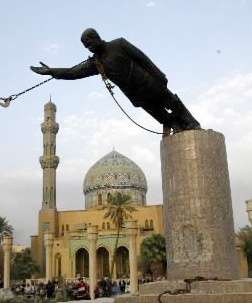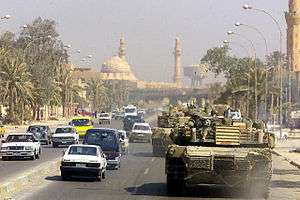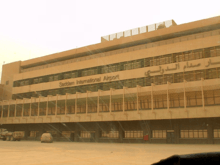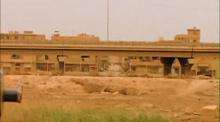Battle of Baghdad (2003)
| Battle of Baghdad (2003) | |||||||
|---|---|---|---|---|---|---|---|
| Part of the 2003 invasion of Iraq | |||||||
 Statue of Saddam Hussein being toppled in Firdos Square | |||||||
| |||||||
| Belligerents | |||||||
|
|
(Air Support) | ||||||
| Commanders and leaders | |||||||
|
| |||||||
| Strength | |||||||
| 45,000 | 30,000 | ||||||
| Casualties and losses | |||||||
|
1,700–2,120 killed (Independent estimate)[2] 2,320 killed (U.S. military estimate)[3] |
34 killed[4] 1 A-10 Thunderbolt II shot down, 2 Abrams tanks destroyed[5] and 17 other vehicles destroyed[6] | ||||||
The Battle of Baghdad, also known as the Fall of Baghdad, was a military invasion of Baghdad that took place in early April 2003, as part of the invasion of Iraq.
Three weeks into the invasion of Iraq, Coalition Forces Land Component Command elements, led by the U.S. Army 3rd Infantry Division moved into Baghdad. The United States declared victory on April 14, and President George W. Bush gave his Mission Accomplished Speech on May 1.
Baghdad suffered serious damage to its civilian infrastructure, economy, and cultural inheritance from the fighting, as well as looting and arson. During the invasion, the Al-Yarmouk Hospital in south Baghdad saw a steady rate of about 100 new patients an hour.[7]
Several thousand Iraqi soldiers were killed in the battle, and a small number of coalition forces. After the fall of Baghdad, Coalition forces entered the city of Kirkuk on April 10 and Tikrit on April 15, 2003.
Preparation

Limited bombing began on March 19, 2003 as United States forces unsuccessfully attempted to kill Saddam Hussein. Attacks continued against a small number of targets until March 21, 2003, when, at 1700 UTC, the main bombing campaign of the US and their allies began. Its forces launched approximately 1700 air sorties (504 using cruise missiles).[8] The invasion of the city commenced three days after Allied forces led by Major General Buford Blount and the 3rd Infantry Division had secured the Baghdad airport.
U.S. officials said that their forces fought skirmishes there with Iraq's Special Republican Guard, with two task forces going up to the Tigris river from the southern outskirts of the city before moving west towards the airport. Major General Victor Renuart said the intention was to indicate to the Iraqi leader that coalition forces could move in and out of Baghdad whenever they wished.[9] The Guardian reported that U.S. forces occupied two "presidential palaces".[10] The Army also surrounded the Information Ministry and other key government installations for a while.[11]
On March 24, retired US Army general Barry McCaffrey, told BBC Newsnight: "If [the Iraqis] actually fight, clearly it's going to be brutal, dangerous work and we could take, bluntly, a couple to 3,000 casualties".[12]
Forces
The invasion of Baghdad was led by the United States Army's 3rd Infantry Division and the United States Marine Corps' 1st Marine Division, equipped with M1 Abrams tanks, Bradley Fighting Vehicles and M113 armored personnel carriers.[13] These forces along with American and British aircraft, including B-52s, Harrier GR7 attack jets and A10 Warthogs,[12] went against the Iraqi Special Republican Guard, of 36,000 soldiers protected in sprawling bunkers 30 miles outside Baghdad, using Asad Babil tanks and heavy artillery.[12]
Aerial bombing
At the time of invasion, coalition aircraft were making bombing runs on Baghdad at the rate of 1,000 sorties a day, most of them aimed at the Republican Guard and Special Republican Guard.[14] U.S. planes also dropped about 200,000 leaflets warning civilians to stay in their homes.[7] Royal Air Force Tornados from 9 and 617 Squadrons attacked the radar defence systems protecting Baghdad, but lost a Tornado on 22 March along with the pilot and navigator (Flight Lieutenant Kevin Main and Flight Lieutenant Dave Williams), shot down by an American Patriot missile as they returned to their airbase in Kuwait.[15] On 2 April, a US Army Black Hawk helicopter and a United States Navy F/A-18C Hornet were shot down near Karbala.[14][16][17][18] On 8 April, an A-10 Warthog attack plane was shot down in the fighting around Jumhuriya Bridge by an Iraqi surface-to-air missile.[19][20]
At Tuwayhah
On April 4, 2003, the 2nd Tank Battalion Marine Corps had a stiff fight with the Al Nida Division of the Republican Guards and foreign Islamist fighters on the outskirts of Baghdad. By the end of the day, the Al Nida was considered rendered "combat-ineffective", but three US Marines (1st Lieutenant Brian McPhillips, Sergeant Duane Rios and Corporal Bernard Gooden[21]) were killed in the At Tuwayhah fighting and a tank lost.[22] That day, the 5th Regimental Combat Team reported that two supporting Abrams tanks were destroyed battling the Fedayeen and Al Nida Republican Guards, the latter attempting to use anti-aircraft guns in the ground role.[5]
Baghdad International Airport

On the morning of April 3, 2003, U.S. forces advanced on Saddam International Airport. This location turned out to be the best defended Iraqi position of the entire war and two US soldiers were killed by mortar fire early in the fighting.[23] After several hours of combat, the First Brigade, Third Infantry Division succeeded in taking control of the Airport, which would become the hub of American logistics in Iraq for the next seven years. Before sunrise on April 4, the Americans were subjected to a fierce counter-attack by Iraqi troops. The First Brigades Tactical Operations Center (TOC) began receiving small arms and mortar fire. Under the cover of darkness, a number of T-72 tanks managed to get within several hundred meters of their position. According to one source: "It was not until a chemical reconnaissance vehicle was fired on, and a Bradley actually was hit by a T-72 main gun round, that the battalion became aware of its peril."[24]
Fortunately for the crew, the hit was only a glancing one, and they were able to drive their vehicle out of harms way. A fire team with a Javelin ATGM destroyed two of the Iraqi tanks, while the rest were destroyed by a passing M1 Abrams. As dawn approached, the attack on the TOC intensified, and Iraqi infantry flooded into the position on foot. During the fighting, Sergeant First Class Paul Ray Smith's actions resulted in the posthumous awarding of division's first Medal of Honor since World War II. During the softening up bombardment of Baghdad Airport on 3 April 2003, an Air Force F-15E fighter mistakenly attacked Battery C, First Battalion, 3-13th Field Artillery (supporting Third Infantry Division), destroying two Humvees and killing Sergeant 1st Class Randy Rehn and Sergeants Donald Oaks and Todd Robins.[25] Five other soldiers from the unit were injured in the air attack. Sergeant 1st Class Wilbert Davis is also reported to have been killed along with US journalist Michael Kelly on 3 April after coming under fire, during operations to secure Baghdad Airport.[26][27]
Thunder Runs
On April 5 Task Force 1–64 Armor of the U.S. Army's 3rd Infantry Division, 2nd Brigade, executed a raid, later called the "Thunder Run", to test remaining Iraqi defenses. The operation began south of Baghdad and went through main roads to the newly secured airport.[28] Iraqi resistance was disorganized, and the unit sustained few casualties. The unit was forced to abandon one tank due to a recoilless rifle or RPG strike in the rear that penetrated a fuel cell and set the engine on fire.[29] The crew was unharmed. Later, the Air Force bombed the tank to destroy it in place, and the Iraqi Information Ministry claimed credit for destroying it.
Two days later, the entire 2nd Brigade of the 3rd Infantry Division was ordered to conduct another "Thunder Run", following the same route as before. This route had been fortified in the intervening period, and senior leaders feared much more substantial resistance than during the prior encounter. COL David Perkins, the brigade's commander, followed the original Thunder Run route north into Baghdad, but then veered east into the government districts instead of west towards the airport. The 2nd Brigade easily took control of what is now the "Green Zone" in one day, dramatically speeding up the end of conventional ground combat in Iraq.[30]
This portion of the battle was described in detail in the book "Thunder Run: The Armored Strike to Capture Baghdad" by David Zucchino, published March 22, 2004.
Objectives Moe, Larry, and Curly
On April 7, 2003 intense fighting took place at three locations known as objectives Moe, Larry, and Curly (named after the characters in The Three Stooges). Each objective was a cloverleaf where east-west roads intersected with the main north-south route (Highway 8) being used for the Thunder run. Successfully holding these highway interchanges was essential to keep Highway 8 open thus allowing US forces to remain in the city center following the second Thunder run. Objective Moe was at the junction of Highway 8 and the Qadisiyah expressway, Larry at Qatar Al-Nada street leading to the Al Jadriyah bridge, and Curly at the Dora expressway. At the southern most location, Objective Curly, an 18-hour battle by the 3-15 Infantry resulted in the deaths of two US soldiers (Staff Sergeant Robert Stever and Sergeant 1st Class John Marshall) killed by RPG rounds and about 40 wounded[31] with 350 to 500 Iraqi casualties (Special Republican Guard, Fedayeen and Syrian fighters[31]). US tank (1st and 4th Battalions of the 64th Armored Regiments) and infantry units nearly ran out of fuel and ammunition and were almost overrun until reinforcements broke through and were able to resupply Objective Curly.[31] Toward the end of the fighting, an Iraqi FROG-7 rocket or an Ababil-100 SSM missile exploded among the parked vehicles of the headquarters of 2nd Brigade, 3rd Infantry Division, killing two soldiers (Private 1st Class Anthony Miller and Staff Sergeant Lincoln Hollinsaid and two embedded journalists (Julio Parrado and Christian Liebig), wounding 15 others and destroying 17 military vehicles.[6] The earlier death of journalist David Bloom, who had been embedded with the 3-15 Infantry, prevented the dramatic fighting from coming to public attention at the time of the battle.
Tharthar Palace

On April 7, U.S. troops took control of a major presidential palace along the Tigris river. It had been hoped that leaders of the regime would be found in the complex, located near Saddam Hussein's home town of Tikrit.[32] American commanders on the ground said that they would remain in the city center rather than return to the outskirts as they had done previously.
Within hours of a palace seizure and with television coverage of this spreading through Iraq, U.S. forces ordered Iraqi forces within Baghdad to surrender, or the city would face a full-scale assault. Iraqi government officials had either disappeared or had conceded defeat.
Jumhuriya Bridge
On 8 April 2003, some 500 Iraqis mounted a fierce counterattack across the Jumhuriya Bridge, forcing part of the U.S. forces on the western side of Baghdad to initially retreat, but the Iraqis reportedly lost 50 killed in the fighting that included the use of A-10 Warthogs on the part of the US forces.[33] An A-10 attack plane was shot down in combating the counterattack by an Iraqi surface-to-air missile.[19][20]
Looting
As the American forces secured control of the capital, Iraqi civilians immediately began looting the palaces, as well as government offices. At the Yarmuk Hospital, not only all beds, but all medical equipment was stolen. One other hospital managed to keep on functioning in a manner by organizing local civilians as armed guards.
Serious looting was described at National Museum of Iraq, and the Saddam Arts Center, the University of Baghdad, three five-star hotels: the Al-Rashid, the Al-Mansour and Babel Hotel, state-owned supermarkets, many embassies, and state-owned factories.[34]
At the National Museum of Iraq, which had been a virtual repository of treasures from the ancient Mesopotamian cultures as well as early Islamic culture, many of the 170,000 irreplaceable artifacts were either stolen or broken (partially found safe and well later). On April 14, the Iraq National Library and National Archives were burned down, destroying thousands of manuscripts from civilizations dating back as far as 7,000 years.[35]
Within eight days following the 2003 invasion, only 35, or 5% of the 700 animals in the Baghdad Zoo survived. This was a result of theft of some animals for human food, and starvation of caged animals that had no food or water.[36] Survivors included larger animals like lions, tigers, and bears.[36] Notwithstanding the chaos brought by the invasion, South African Lawrence Anthony and some of the zoo keepers cared for the animals and fed the carnivores with donkeys they had bought locally.[36][37]
Political control
As the U.S. forces were occupying the Republican Palace and other central landmarks and ministries on April 9, Saddam Hussein had emerged from his command bunker beneath the Al A'Zamiyah district of northern Baghdad, and greeted excited members of the local public. This impromptu walkabout was probably his last and his reasons for doing so are still unclear. It is possible that he wished to take what he thought might be his last opportunity to greet his people as their country's president. The walkabout was captured on film and broadcast several days after the event on Al-Arabia Television and was also witnessed by ordinary people who corroborated the date afterwards. He was accompanied by bodyguards and other loyal supporters including at least one of his sons and his personal secretary. After the walkabout Hussein returned to his bunker and made preparations for his family.
On April 9, 2003, Baghdad was formally occupied by Coalition forces. Much of Baghdad remained unsecured however, and fighting continued within the city and its outskirts well into the period of occupation. Saddam, certain members of his family and close subordinates had vanished, and his whereabouts were unknown.
Many Iraqis celebrated the downfall of Saddam by vandalizing the many portraits and statues of him together with other pieces of his legacy. One widely publicized event was the dramatic toppling of a large statue of Saddam in Baghdad's Fardus Square. This attracted considerable media coverage at the time.
Firdos Square statue destruction
Before a conglomerate of international press (and small crowd of around 100 U.S.-supported Iraqi militia[38][39]), a 20-foot-tall (6.1 m) statue of Saddam in Firdus Square was toppled by an U.S. Marine Corps M88 Recovery Vehicle. Initially, a Marine corporal named Edward Chin of the 3rd Battalion, 4th Marines Regiment placed a United States flag on the statue's head, though it was replaced with an Iraqi flag. Various other symbols of the president were defaced.
Search for Hussein
The Americans had meanwhile started receiving rumors that Saddam was in Al A'Zamiyah and at dawn on April 10, they dispatched three companies of U.S. Marines to capture him. The marines fought a fierce four-hour battle at a Baghdad mosque where senior Iraqi leaders had been thought to be holed up, as American warplanes attacked areas of the city under the control of Iraqi fighters. "We had information that a group of regime leadership was attempting to organize a meeting. The fighting in and around the mosque complex could not be avoided as enemy forces were firing from the area of the mosque." said Navy captain Frank Thorp. Marines came under fire from rocket-propelled grenades, mortars and assault rifles. One marine was killed and more than 20 were wounded, but neither Saddam nor any of his aides were found.
Reporting

Iraq, which had no free press, initially issued a statement contradicting western reporters' accounts of the invasion. Muhammed Saeed al-Sahaf, head of the Information Ministry, told a press conference on April 7 that there were no U.S. troops in Baghdad, saying: "Their infidels are committing suicide by the hundreds on the gates of Baghdad. Be assured, Baghdad is safe, protected. Iraqis are heroes."[40]
On April 8, two American air to surface missiles hit Al Jazeera's office in Baghdad and killed a reporter and wounded a cameraman. The nearby office of Arab satellite channel Abu Dhabi TV was also hit by air strikes. Al Jazeera accused the U.S. of attacking Arab media to hide facts. On the same day a U.S. Army tank fired into the 15th floor of the Palestine Hotel in Baghdad, where almost all foreign journalists resided, and killed two cameramen and wounded three. In the Abu Dhabi case, the station aired the picture of Iraqi fire from beneath the camera. In the hotel case, however, other journalists on the scene denied any fire from or around the hotel.[41][42]
External links
- U.S. Forces Enter the Heart of Baghdad
- US Forces Occupy Palaces – The Guardian
- Washington Post Daybook – Tuesday, April 8, 2003; Page A25
- Iraqi museum of antiquities looted; 8000 year old treasures lost forever
- Iraqi Perspectives Report, Joint Center for Operational Analysis at United States Department of Defense, March 2006
References
- ↑ Woods, Kevin M. (2009). Iraqi Perspectives Project: A View of Operation Iraqi Freedom from Saddam's Senior Leadership (PDF). p. 145; 210. ISBN 0-9762550-1-4.
- ↑ The Wages of War – Appendix 1. Survey and assessment of reported Iraqi combatant fatalities in the 2003 War
- ↑ Iraqi Death Toll, Health Perils Assessed by Medical Group
- ↑ Iraq Coalition Casualties: Military Fatalities
- 1 2 "On April 4, 5th RCT ran into several hundred fedayeen from Syria, Jordan, Egypt, and other parts of the Middle East and Africa. The result was wholesale slaughter, but the cost was considerable: two Abrams tanks were destroyed by the attackers, while numerous vehicles sustained damage from RPG fire. The marines killed a senior general from the Republican Guard ... In addition, marine tankers destroyed twelve to fifteen T-72s and T-55s as well as numerous 37mm anti-aircraft guns, which the Iraqis attempted to use against advancing marines." The Iraq War, Wiiliamson Murray, Robert Scales, p.225, Harvard University Press, 2005
- 1 2 Iraqi Missile Hits Army Base
- 1 2 Zoroya, Gregg; Walt, Vivienne (April 7, 2003). "USATODAY.com – From the battered streets of Baghdad, it's clear: 'The battle has reached us'". USA Today. Retrieved April 10, 2010.
U.S. planes also dropped about 200,000 leaflets warning civilians to stay in their homes
- ↑ "Operation Iraqi Freedom – By the Numbers", USCENTAF, April 30, 2003, 15.
- ↑ "US forces raid Baghdad". BBC News. April 5, 2003. Retrieved April 26, 2010.
- ↑ Jeffery, Simon (April 7, 2003). "US forces occupy palaces". The Guardian. London. Retrieved April 26, 2010.
- ↑ "DAYBOOK : A look at the day's major developments in the war with Iraq". The Washington Post. April 8, 2003. Retrieved April 26, 2010.
- 1 2 3 "Battle for Baghdad begins". Retrieved April 10, 2010.
http://www.guardian.co.uk/world/2003/mar/25/iraq.rorymccarthy
- ↑ Sipress, Alan (April 5, 2003). "U.S. Forces Enter the Heart of Baghdad". Washington Post. Retrieved November 19, 2006.
- 1 2 Tyler, Patrick E. (April 3, 2003). "Combat - U.S. Ground Forces Sweep Toward Baghdad - NYTimes.com". The New York Times. Archived from the original on October 28, 2014. Retrieved April 10, 2010.
Allied aircraft are making bombing runs at the rate of 1,000 sorties a day, most of them aimed at Mr. Hussein's guard divisions.
- ↑ 'Glaring failures' caused US to kill RAF crew
- ↑ "On April 2, 2003, a U.S. Army Sikorsky H-60 Black Hawk helicopter was shot down near Karbala, killing seven soldiers and wounding four others. This event appeared to indicate a significant enemy presence in the city. The Encyclopedia of Middle East Wars: The United States in the Persian Gulf, Afghanistan, and Iraq Conflicts, Spencer C. Tucker, p. 672, ABC-CLIO, 2010
- ↑ Troops Near Baghdad; Us Jet, Helicopter Shot Down
- ↑ "On April 2 a navy FA-18 was shot down west of Karbala, Iraq." Leave No Man Behind: The Saga of Combat Search and Rescue, George Galdorisi, Thomas Phillips, p. 519, Zenith Imprint, 2008
- 1 2 "A-10 aircraft strafed both sides of the main road leading to the bridge and one aircraft was lost to a shoulder-launched missile." Cradle of Conflict: Iraq and the Birth of Modern U.S. Military Power, Michael Knights, p.326, Naval Institute Press, 2005
- 1 2 IRAQIS SHOOT DOWN A-10
- ↑ U.S. Military Deaths in War With Iraq -- 2003
- ↑ Marines stand their ground as ambush rages on
- ↑ Iraq Special Guard Promises Stiff Test
- ↑ James Lacey (2007). Takedown: the 3rd Infantry Division's twenty-one day assault on Baghdad. Naval Institute Press. p. 200. ISBN 9058230457.
- ↑ Pennsylvania soldier killed by friendly fire
- ↑ U.S. begins second wave of incursions into Baghdad
- ↑ A Stupid Death in a Stupid War: Remembering Michael Kelly
- ↑ Michael R. Gordon; Bernard E. Trainor (2007). Cobra II: The Inside Story of the Invasion And Occupation of Iraq. Vintage Books. pp. 378–379. ISBN 978-1-4000-7539-3.
- ↑ Gordon and Trainor, 380-381.
- ↑ Gordon and Trainor, 390-410.
- 1 2 3 Battle Of Baghdad
- ↑ "US poised for Baghdad battle". BBC. April 3, 2003. Retrieved April 10, 2010.
- ↑ Iraqis Launch Counterattack In Baghdad; 50 Reported Killed
- ↑ Collier, Robert (April 12, 2003). "Looters shake Iraqi cities / CHAOS: Troops watch as Baghdad is ransacked – SFGate". The San Francisco Chronicle. Retrieved April 10, 2010.
- ↑ Eskander, Saad. "The Tale of Iraq's 'Cemetery of Books' " (cover story), in: Information Today; Dec 2004, Vol. 21, issue 11, p. 1-54; 5 pl, 1 color
- 1 2 3 "The Choice, featuring Lawrence Anthony". BBC radio 4. September 4, 2007. Retrieved September 4, 2007.
- ↑ Anthony, Lawrence; Spence Grayham (June 3, 2007). Babylon's Ark; The Incredible Wartime Rescue of the Baghdad Zoo. Thomas Dunne Books. ISBN 0-312-35832-6.
- ↑ The photographs tell the story
- ↑ Ludwig, Steve (May 29, 2003). "Lights, camera, rescue". Seattle Post-Intelligencer.
- ↑ "World News, Business News, Breaking US & International News". Reuters.
- ↑ Perlez, Jane (April 8, 2003). "At Least 3 Journalists Die in Blast at Baghdad Hotel". The New York Times. Archived from the original on April 22, 2009. Retrieved March 28, 2010.
- ↑ http://story.news.yahoo.com/news?tmpl=story2&cid=1503&ncid=1503&e=1&u=/afp/20030408/ts_afp/iraq_war_baghdad_media_030408165654
Coordinates: 33°20′00″N 44°26′00″E / 33.3333°N 44.4333°E
